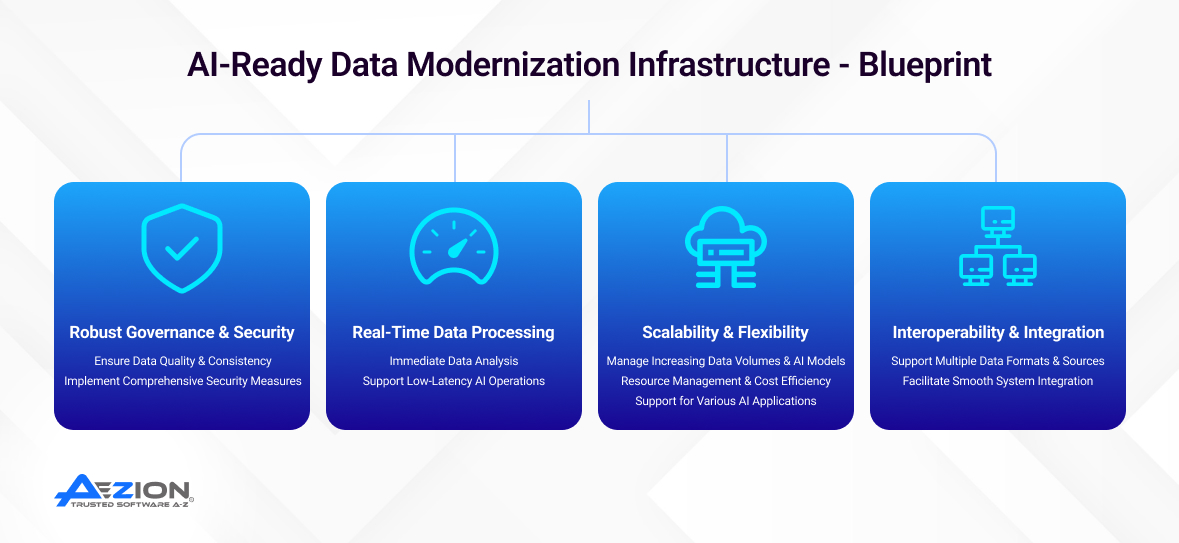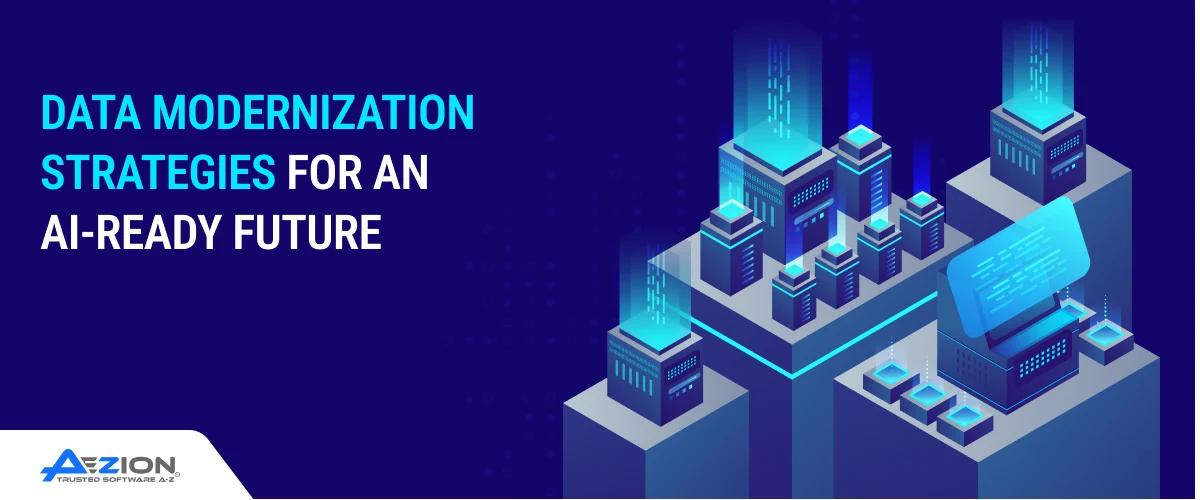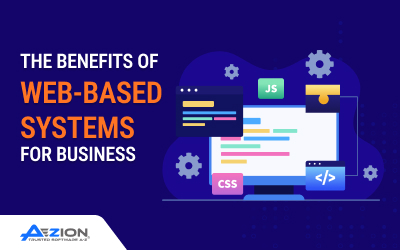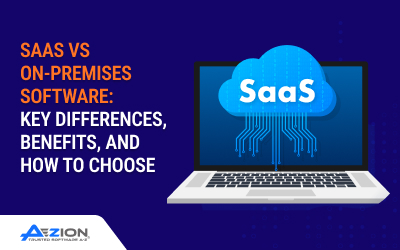Introduction
Data is the foundation of any AI-driven innovation; many business owners are adopting the latest tech, like AI, to stay ahead of the competition and create advanced operational processes. Now, to use the full potential of AI, businesses need a strong and scalable data ecosystem that manages, supports innovations, and offers fast data processing services.
Many companies depend on legacy data management systems, which fail to meet modern AI implementations due to the limitations of data readiness and data fragmentation across multiple systems. An urgent need for data modernization has arisen to bridge this gap, as it helps transform data infrastructures to enable AI-driven success.
This blog will show how impactful strategies to modernize data can help businesses have an AI-ready future and what blueprint data engineering companies are implementing for different industries.
A Legacy Data Management Approach Can Impede Your AI Goals
In the world of AI-driven transformation within industries, data plays the most important role for all. Factors like quality of data, accessibility level, and strategy all play an important role in ensuring your business infrastructure meets evolving market needs. However, many organizations dealing with legacy data management often falls behind to meet the modern AI application standards as the traditional approach lacks solid data strategies and governance and face data silos at the core.
A 2024 survey report from Capital One says that 87% of businesses see their data ecosystem as a ready asset for creating an AI platform, but 70% of professionals still need to spend money fixing data issues.
Some of the core reasons for the gap in Artificial Intelligence data readiness are –
Outdated Data Infrastructure
Outdated data architecture is arguably the most significant challenge for any organization when getting AI-ready. These legacy architectures are often dated and built to support siloed and narrow data, and do not enable organizations with the scale, flexibility, and integrations needed for AI and automation.
Outdated architectures also struggle to aggregate data from various internal and external sources, creating operationally siloed insights and wasting time when making decisions. Often, an organization does not have the infrastructure to act on real-time risk or opportunity. Incompatibility and disconnection from modern tools and cloud-native workloads stifles innovation.
To launch AI-enabled transformation, organizations focus on modernizing data architecture and implementing interoperability, ensuring access to reliable data, and creating a scalable architecture that supports advanced analytics and automation.
Data Governance
Data governance involves specific data management across companies by defining its storage and accessibility. However, a survey says that 62% of organizations find it difficult to identify data governance. As companies grow, building a framework around data becomes more critical.
Therefore, having a well-designed governance program guarantees data security and usability for AI-driven solutions.
Data Silos and Quality
To unlock the full potential of AI, data must be easily accessible by every department of the organization. Unfortunately, many companies struggle with data silos where the companies have data spread across different departments.
Besides this, data quality is also a considerable issue. To be AI-ready, organizations must have clean, relevant, and accurate data, which is difficult with traditional approaches. Data modernization is essential to eliminating outdated and erroneous data and leveraging high-quality and well-structured AI initiatives.
Understanding Data Modernization for AI-Readiness
Data modernization is transforming data accessibility to improve business intelligence and decision-making. It enables companies to evolve their data systems, infrastructures, and practices to enhance security and business intelligence for an AI-ready future.
A recent 2025 survey report by Kyndryl specifies that 62% of organizations acknowledged significant gaps in their AI readiness regarding data ecosystems and infrastructure, and they require modernization to support AI initiatives.
Also, Business Insider mentions that over 75% of service providers consider investing in data modernization by realizing the potential of generative AI to enhance data quality and governance.
Blueprint of an AI-Ready Data Modernization Infrastructure

Preparing your organization’s data infrastructure for AI is essential to surpass competition in a rapidly evolving digital landscape. An AI-ready data modernization infrastructure must include some key attributes, such as –
Robust Governance and Security
Data protection, compliance, and quality are the most important aspects to focus on for an AI-ready infrastructure.
- Data Quality and Consistency: If you have poor data, you will have unreliable AI outcomes, ‘garbage in, garbage out’. Companies should have frameworks that ensure high data standards, so the insights will mean something, and automation will be reliable.
- Implement Security Measures: To protect data from unauthorized access, breaches, and threats, and maintain users’ trust and compliance, implementing security measures is necessary.
- Ethics and Compliance: Ensure that human decision-making is a component of the governance model to assess data sensitivity and ethical consequences before data is used in AI systems.
Scalability and Flexibility
AI-ready infrastructure must easily and seamlessly adapt to the growing business demands and modern approach requirements.
- Increasing Data Volumes and Complex AI Models: Data engineers help companies develop systems that manage growing datasets and support complicated AI algorithms.
- Resource and Cost Management: Cloud environments need to scale on demand and have controls in place to manage costs from a business consumption perspective. These controls should include workload monitoring, query validation, and operational efficiencies to prevent cost overruns from poorly optimized pipelines or unpredictable usage.
- Support for Diverse AI Applications: The AI-ready data modernization infrastructure should accommodate various AI applications, from small-scale to enterprise-level deployments.
Real-Time Data Processing
Having an infrastructure that offers timely insights is crucial for any organization that aims to have an AI-ready ecosystem.
- Immediate Data Analysis: Data analytics engineers must process and analyze data as it arrives in the system to offer prompt actions and insights.
- Support Low-Latency Operations: To confirm the effectiveness of AI applications, companies must focus on eliminating or maintaining delays in data processing methods.
Interoperability and Integration
The company’s infrastructure becomes AI-ready when there is a seamless connection between different data sources and business operational systems.
- Support Data Formats and Sources: Integrating the company’s structured and unstructured data from internal and external sources is necessary.
- Facilitate Smooth System Integration: Any company’s tools and systems must create a cohesive data ecosystem.
Modernizing Industries for an AI-Ready Future
Data modernization is revolutionizing varied industries by making integration of advanced technology possible while enhancing every business’s accuracy, efficiency, and decision-making power. Here, we will look at current trends, strategies for implementation, and AI-driven use cases across different industries, such as healthcare, finance, and manufacturing.
Data Modernization in Healthcare
Current Trends and Statistics
Trends and statistics specify the demand and benefits of AI, which can be achieved by modernizing company data and insights.
- AI Adoption
With time, the healthcare sector has evolved by adapting to the latest technologies, and now it’s embracing artificial intelligence (AI) to improve patient care and operational efficiency. A recent report from Grand View Research specifies that as of 2023, the value of global AI in the healthcare market was approximately USD 19.27 billion, and from 2024 to 2030, it is estimated to reach a compound annual growth rate (CAGR) of 38.5%.
- Market Growth
As the AI market grows, the requirement for accurate, efficient, and better patient care increases. Referring to the March 2024 Microsoft-IDC study, 79% of healthcare organizations are using AI technology to take advantage of this market status, and the return on investment (ROI) calculated within 14 months of adopting AI is USD 3.20 for every USD 1 invested by the company.
Strategies for Implementation
- Transition from Paper-Based to Digital Records: To become AI-ready, organizations’ initial step is to shift away from manual methods to electronic health records (EHRs). EHRs can enhance data accessibility for patients and healthcare professionals.
- Data Security Upgrades: Data security enhancements become necessary. Companies can focus on data encryption, real-time auditing, and role-based access control (RBAC) to ensure GDPR and HIPAA compliance.
- Interoperability Standards: Every healthcare organization is required to implement FHIR (Fast Healthcare Interoperability Resources) to make sure there is efficient data sharing between hospitals, patients, insurance companies, and diagnostic labs.
Use Cases for an AI-Driven Future
- Personalized Healthcare: Data can revolutionize patient care by detecting health issues like heart rate and helping patients take immediate action through Bluetooth-powered inhalers and digital watches.
- Real-time Monitoring: With data modernization in the healthcare industry, hospitals can efficiently operate essential insights operational dashboards, monitor real-time data, forecast patient loads, and enhance patient care through dynamic healthcare dashboard portals.
Data Modernization in Finance
Current Trends and Statistics
- AI Integration
The financial sector rapidly adopts AI to eliminate fraud and data breaches while enhancing data services and security. In 2025, 45% of financial companies are estimated to adopt AI, according to a report by Statista.
- Market Dynamics
Through the advancement of technology, the finance industry is shifting towards data modernization. AI is instrumental in transforming traditional financial services.
Strategies for Implementation
- Centralized Data Lakes: Centralizing your finance company’s data lakes is the most essential step towards being ready for AI. Compiling data from various financial services in one place is necessary since it can provide uniformity and compliance with regulations.
- Automated Compliance Monitoring: Data lineage tracking is a must to have an effective compliance monitoring system, as it allows for maintaining data transparency for fraud probes and yearly audits.
- Real-Time Transaction Processing: Transforming the legacy financial system to real-time processing frameworks like Apache Kafka can result in faster settlements.
Use Cases for an AI-Driven Future
- Customer Experience: With data modernization, digital-first banks can personalize customer services and workflows and offer them a better experience than the traditional banking model.
- Automated decision-making: Finance companies can leverage machine learning to automate approval or rejection processes and reduce manual interventions.
Data Modernization in Manufacturing
Current Trends and Statistics
- AI Adoption
A survey from Precedence Research on AI usage in the manufacturing industry estimates that the market will grow from $5.94 billion in 2024 to $8.57 billion in 2025 and reach $230.95 billion by 2034. The statistics clearly show that the manufacturing sector is adopting AI at a rapid pace.
- Market Dynamics
Manufacturing firms are leveraging data modernization and artificial intelligence to automate mission-critical functions, anticipate equipment breakdowns ahead of time, improve quality assurance, reduce maintenance expenses, and avoid production shutdowns.
- IoT Data Integration: Manufacturing firms can link factory equipment with cloud-based data platforms, providing real-time product information and insightful data monitoring.
- Digital Twin Technology Preparation: Creating a data structure capable of supporting real-time virtual copies of the company’s manufacturing operations can enable it to embrace AI a step ahead.
- Predictive Maintenance Data Standardization: Data standardization, which collects data from different machines, is one of the most crucial steps to ensure seamless analysis. To do this, companies collect data from various types of machines.
Use Cases for an AI-Driven Future
- Predictive Maintenance: Predictive maintenance is possible by analyzing real-time data. Manufacturers leverage data modernization methods to identify potential failures before they happen and ensure continuous productivity.
- Enhanced Operational Efficiency: When manufacturing companies get real-time insights into their production unit, they can easily improve operational efficiency by identifying quality issues.
- Production, Inventory, and Catalog Management: AI and modern data infrastructure can optimize production scheduling, dynamic inventory management, and create accurate product catalogs. These allow for excess manufacturing and inventory reductions in the supply chain.
Data Modernization in Retail
Current Trends and Statistics
- The global AI in retail market is projected to grow from $9.36 billion in 2024 to $85.1 billion by 2032, expanding at a CAGR of 31.8%.
- 85% of online retailers plan to increase AI spending, while AI chatbots already handle up to 75% of customer service queries.
Strategies for Implementation
- Integrated Cloud Data Lakes: All data from e-commerce platforms, stores, IoT sensors, CRMs, and inventory systems should come together into cloud data lakes, providing greater resources for AI training and insights.
- Real-Time Analytics Pipelines: Leverage streaming technologies to stream customer interactions and product availability status in real-time to design dynamic prices to capitalize on customer demand while also aiding predictive stocking and shipping.
- Ethical Data Contexts: Ethical data practices should be done using data governance and bias auditing frameworks to build trust in AI-based recommendations and new, more stringent privacy standards
Use Cases for an AI-Driven Future
- Personalized Shopping Experience: AI-powered platforms can use more data from behavioral and transactional data to personalize product recommendations, emails, and websites in context.
- Stock & Demand Forecasting: Predictive analytics applications can utilize various types of customer data in near real-time from multiple sources to enhance forecasts of purchasing behavior and minimize stock-outs or over-purchasing.
- Store Intelligence: Vision AI and IoT sensors can be used to create heatmaps of customer behavior, enabling the optimization of each store’s layout, staffing, and conversion rates.
Data Modernization in Construction
Current Trends and Statistics
- 78% of construction firms have implemented digital transformation measures—from BIM and IoT to AI tools—to boost efficiency and tracking
- 45% of construction companies are actively using AI-powered safety monitoring systems, leading to up to a 40% reduction in on-site accidents.
Strategies for Implementation
- Cloud-Based Project Management and BIM Integration: Construction companies are transitioning from traditional, siloed systems to modern cloud-based systems that also integrate Building Information Modeling (BIM). This enables project information to be stored in a single online collaborative space, providing customized access to all stakeholders.
- AI and Incident Prevention: Modern construction sites leverage AI technologies to enhance safety, in part by continuously searching live feeds and sensor data for indications of risk, for early indications of errors, and structural flaws. These systems will lead to a reduced burden of rework, lost time due to disruption, and a likely reduction in the number of on-site incidents.
- IoT and Drones: The Connected Internet of Things and drone technology continuously harvest live data on working conditions and parameters, equipment health and capability, and the status of construction work. The harvested data is fused and synchronized with dashboard/analytics tools used to inform decision-making.
Use Cases for an AI-Driven Future
- Predictive Scheduling and Budget Control: AI technologies utilize parameters related to timelines, labor, and material flow to maintain a forecast of both schedule risk and budget overrun. This enables work teams to adjust their plans to achieve optimal efficiency proactively.
- Automated Safety Monitoring and Incident Prevention: AI technologies utilize real-time video data from site cameras and sensory data from wearables and platforms to continuously analyze whether unsafe behaviors or conditions exist. More importantly, AI technology provides automated alerts to help prevent accidents and comply.
Quality Inspection and Defect Detection: Computer vision systems enable more rapid and precise inspections by eliminating human issues like bias and fatigue that lead to non-detection of structural defects, design errors, or workmanship defects, and improve the build quality and reduce costly rework.
Conclusion
This blog shows that a firm’s data foundation must be robust to be AI-ready. As the organization progresses, it becomes essential to modernize the data ecosystem. Implementing a systematic approach to data modernization, making it scalable, integrating it seamlessly, and processing data in real-time from disparate sources can lay a solid groundwork for an organization’s AI-driven success.
To fully leverage AI and stay competitive, you can partner with Aezion’s data engineering team to modernize your infrastructure for a smarter, more scalable future.




